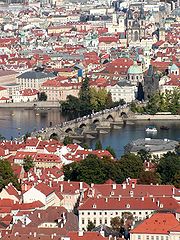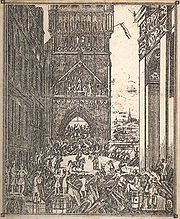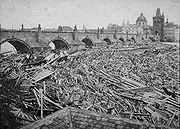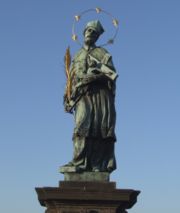
Charles Bridge
Encyclopedia

Vltava
The Vltava is the longest river in the Czech Republic, running north from its source in Šumava through Český Krumlov, České Budějovice, and Prague, merging with the Elbe at Mělník...
river in Prague
Prague
Prague is the capital and largest city of the Czech Republic. Situated in the north-west of the country on the Vltava river, the city is home to about 1.3 million people, while its metropolitan area is estimated to have a population of over 2.3 million...
, Czech Republic. Its construction started in 1357 under the auspices of King Charles IV
Charles IV, Holy Roman Emperor
Charles IV , born Wenceslaus , was the second king of Bohemia from the House of Luxembourg, and the first king of Bohemia to also become Holy Roman Emperor....
, and finished in the beginning of the 15th century. As the only means of crossing the river Vltava (Moldau) until 1841, the Charles Bridge was the most important connection between Prague Castle
Prague Castle
Prague Castle is a castle in Prague where the Kings of Bohemia, Holy Roman Emperors and presidents of Czechoslovakia and the Czech Republic have had their offices. The Czech Crown Jewels are kept here...
and the city's Old Town
Old Town, Prague
Old Town is a medieval settlement of Prague, Czech Republic. It was separated from the outside by a semi-circular moat and wall, connected to the Vltava at both of its ends. The moat is now covered up by the streets Revolučni, na Příkopě, and Národni—which remain the official boundary of the...
and adjacent areas. This "solid-land" connection made Prague important as a trade route between Eastern and Western Europe. The bridge was originally called the Stone Bridge (Kamenný most) or the Prague Bridge (Pražský most) but has been the "Charles Bridge" since 1870.
The bridge is 516 meters long and nearly 10 meters wide, resting on 16 arches shielded by ice guards. It is protected by three bridge towers, two of them on the Lesser Quarter
Malá Strana
Malá Strana is a district of the city of Prague, Czech Republic, and one of its most historic regions.The name translated into English literally means "Little Side", though it is frequently referred to as "Lesser Town", "Lesser Quarter", or "Lesser Side"...
side and the third one on the Old Town
Old Town, Prague
Old Town is a medieval settlement of Prague, Czech Republic. It was separated from the outside by a semi-circular moat and wall, connected to the Vltava at both of its ends. The moat is now covered up by the streets Revolučni, na Příkopě, and Národni—which remain the official boundary of the...
side. The Old Town bridge tower is often considered to be one of the most astonishing civil gothic
Gothic architecture
Gothic architecture is a style of architecture that flourished during the high and late medieval period. It evolved from Romanesque architecture and was succeeded by Renaissance architecture....
-style buildings in the world. The bridge is decorated by a continuous alley of 30 statues and statuaries, most of them baroque
Baroque
The Baroque is a period and the style that used exaggerated motion and clear, easily interpreted detail to produce drama, tension, exuberance, and grandeur in sculpture, painting, literature, dance, and music...
-style, originally erected around 1700 but now all replaced by replicas.
At night Charles Bridge is a quiet place, but during the day it changes its face into a very busy venue with painters, owners of kiosks, and vendors alongside numerous tourists crossing the bridge.
Through the 19th century

Flood
A flood is an overflow of an expanse of water that submerges land. The EU Floods directive defines a flood as a temporary covering by water of land not normally covered by water...
in 1432 damaged three pillars. In 1496 the third arch (counting from the Old Town side) broke down after one of the pillars lowered, being undermined by the water (repairs were finished in 1503). A year after the Battle of White Mountain
Battle of White Mountain
The Battle of White Mountain, 8 November 1620 was an early battle in the Thirty Years' War in which an army of 30,000 Bohemians and mercenaries under Christian of Anhalt were routed by 27,000 men of the combined armies of Ferdinand II, Holy Roman Emperor under Charles Bonaventure de Longueval,...
, when the 27 leaders of the anti-Habsburg
Habsburg
The House of Habsburg , also found as Hapsburg, and also known as House of Austria is one of the most important royal houses of Europe and is best known for being an origin of all of the formally elected Holy Roman Emperors between 1438 and 1740, as well as rulers of the Austrian Empire and...
revolt were executed on 21 June 1621, the Old Town bridge tower served as a deterrent display of the severed heads of the victims to stop Czechs from further resistance. During the end of the Thirty Years' War
Thirty Years' War
The Thirty Years' War was fought primarily in what is now Germany, and at various points involved most countries in Europe. It was one of the most destructive conflicts in European history....
in 1648, the Swedes
Sweden
Sweden , officially the Kingdom of Sweden , is a Nordic country on the Scandinavian Peninsula in Northern Europe. Sweden borders with Norway and Finland and is connected to Denmark by a bridge-tunnel across the Öresund....
occupied the west bank of the Vltava, and as they tried to advance into the Old Town the heaviest fighting took place right on the bridge. During the fighting, they severely damaged one side of the Old Town bridge tower (the side facing the river) and the remnants of almost all gothic decorations had to be removed from it afterward. During the late 17th century and early 18th century the bridge gained its typical appearance when an alley of baroque statues was installed on the pillars. During a great flood in 1784, five pillars were severely damaged and although the arches did not break down, the traffic on the bridge had to be greatly restricted for some time.

Bus
A bus is a road vehicle designed to carry passengers. Buses can have a capacity as high as 300 passengers. The most common type of bus is the single-decker bus, with larger loads carried by double-decker buses and articulated buses, and smaller loads carried by midibuses and minibuses; coaches are...
) line went over the bridge (officially called "Charles Bridge" after 1870), later replaced by a horse tram. The bridge towers underwent a thorough reconstruction between 1874 and 1883.
On 2–5 September 1890, another disastrous flood struck Prague and severely damaged the Charles Bridge. Thousands of rafts, logs and other floating materials that escaped from places upstream gradually formed a huge barrier leaning against the bridge. Three arches were torn down from the great pressure and two pillars collapsed from being undermined by the water, while others were partly damaged. With the fifth pillar, two statues – St. Ignatius of Loyola
Ignatius of Loyola
Ignatius of Loyola was a Spanish knight from a Basque noble family, hermit, priest since 1537, and theologian, who founded the Society of Jesus and was its first Superior General. Ignatius emerged as a religious leader during the Counter-Reformation...
and St. Xavier
Francis Xavier
Francis Xavier, born Francisco de Jasso y Azpilicueta was a pioneering Roman Catholic missionary born in the Kingdom of Navarre and co-founder of the Society of Jesus. He was a student of Saint Ignatius of Loyola and one of the first seven Jesuits, dedicated at Montmartre in 1534...
, both by Ferdinand Brokoff
Ferdinand Brokoff
Ferdinand Maxmilian Brokoff was a sculptor and carver of the Baroque era....
– also fell into the river. The former statue was replaced by a statuary of Saints Cyril and Methodius
Saints Cyril and Methodius
Saints Cyril and Methodius were two Byzantine Greek brothers born in Thessaloniki in the 9th century. They became missionaries of Christianity among the Slavic peoples of Bulgaria, Great Moravia and Pannonia. Through their work they influenced the cultural development of all Slavs, for which they...
by Karel Dvořák; the latter was replaced by a replica of the original. Repair works lasted for two years (the bridge was reopened on 19 November 1892) and cost 665,000 crowns
Austro-Hungarian krone
The Krone or korona was the official currency of the Austro-Hungarian Empire from 1892 until the dissolution of the empire in 1918...
.

20th century to present

World War II
World War II, or the Second World War , was a global conflict lasting from 1939 to 1945, involving most of the world's nations—including all of the great powers—eventually forming two opposing military alliances: the Allies and the Axis...
, a barricade was built in the Old Town bridge tower gateway. A capital repair of the bridge took place between 1965 and 1978, based on a collaboration among various scientific and cultural institutes. The stability of the pillars was reassured, all broken stone blocks were replaced, and the asphalt top was removed. All vehicular traffic has been excluded from the Charles Bridge since then, making it accessible by pedestrians only. The repair cost 50 million crowns.
During the 1990s, some people started criticizing the previous reconstruction of the bridge and proposing a new one. As of the beginning of the new millennium, most of the experts appeared to agree that the previous reconstruction had not been flawless but disputed the need for further interference with the bridge. However, after the disastrous floods of 2002 (which themselves caused only minor harm to the bridge), it was decided that repair and stabilization of the two pillars (numbers 8 and 9) on the Malá Strana side of the bridge would happen. These are the only river pillars that were not repaired after the 1890 floods. The floods intensified the voices of those supporting an overall bridge reconstruction. Work started in late 2008 and is scheduled to continue through 2010. The works includes bolstering the pillars and building a new hydroisolation system protecting the bridge. It also encompasses the replacement of many of the stones in the bridge walls, a matter which has become enormously controversial due to the heavy handed and, many say, inappropriate approach adopted by the restoration team. The result has been highly criticised by conservation professionals all over Europe (see photos on external links). Even laypeople walking across the bridge can easily see that dozens of new replacement "stones" do not match the historical ones they are next to. The whole reconstruction is being done gradually, closing off parts of the bridge without needing to close the span in its entirety.
Statues on the bridge
The avenue of 30 mostly baroque statues and statuaries situated on the balustrade forms a unique connection of artistic styles with the underlying gothic bridge. Most sculptures were erected between 1683 and 1714. They depict various saintSaint
A saint is a holy person. In various religions, saints are people who are believed to have exceptional holiness.In Christian usage, "saint" refers to any believer who is "in Christ", and in whom Christ dwells, whether in heaven or in earth...
s and patron saint
Patron saint
A patron saint is a saint who is regarded as the intercessor and advocate in heaven of a nation, place, craft, activity, class, clan, family, or person...
s venerated at that time. The most prominent Bohemian sculptors of the time took part in decorating the bridge, such as Matthias Braun
Matthias Braun
Matthias Bernard Braun was a sculptor and carver active in the Czech lands, one of the most prominent late baroque style sculptors in the area....
, Jan Brokoff
Jan Brokoff
Jan Brokoff, also known as Johann Brokoff, was a baroque-era sculptor and carver.Brokoff was of German origin, born in Spišská Sobota, today in Slovakia, then in Royal Hungary, and later working and living in Bohemia...
, and his sons Michael Joseph
Michael Brokoff
Michael Johann Joseph Brokoff was a Czech sculptor of the Baroque era, working with sandstone....
and Ferdinand Maxmilian
Ferdinand Brokoff
Ferdinand Maxmilian Brokoff was a sculptor and carver of the Baroque era....
.
Among the most notable sculptures, one can find the statuaries of St. Luthgard, the Holy Crucifix and Calvary, and St. John of Nepomuk
John of Nepomuk
John of Nepomuk is a national saint of the Czech Republic, who was drowned in the Vltava river at the behest of Wenceslaus, King of the Romans and King of Bohemia. Later accounts state that he was the confessor of the queen of Bohemia and refused to divulge the secrets of the confessional...
. Well known also is the statue of the knight Bruncvík, although it was erected some 200 years later and does not belong to the main avenue.
Beginning in 1965, all of the statues have been systematically replaced by replicas, and the originals have been exhibited in the lapidarium of the National Museum.

